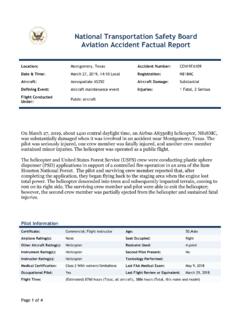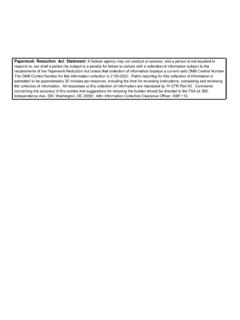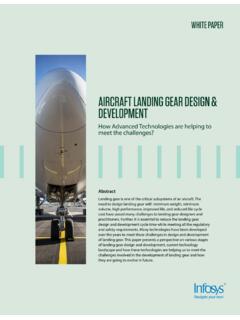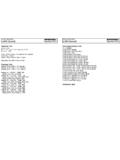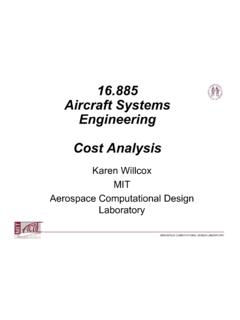Transcription of Smarter MRO 5 strategies for increasing speed, improving ...
1 Smarter MRO. 5 strategies for increasing speed, improving reliability, and reducing costs all at the same time Contents Introduction 3. The end state: An integrated approach to MRO 4. Achieve short and consistent turnaround time (TAT) using a combination of lean, Six Sigma, theory of constraints, and information 5. Improve the design and planning of maintenance 7. Reduce inventory, while increasing service levels 9. Select the right MRO IT solution and extract value from that investment 13. Craft a fact-based outsourcing strategy 16. Conclusion 19. Contacts 20. Introduction It's tougher than ever to perform MRO operations efficiently and effectively. From outside, material costs are rising. From A few leading airlines and MRO companies inside, siloed processes, disparate systems, and data overload have figured out how to exploit make it hard to coordinate the whole MRO process, from scheduling and forecasting to inventory management and opportunities to reduce the cost of replenishment.
2 Only a few airframe, engine and component maintenance, repair, and overhaul (MRO) MRO companies have an approach that enables simplification, standardization, speed, and do it right the first time quality. operations by 8-15 percent. What do they But those that do are reducing total costs by 8-15 percent know that their competitors don't? initially and achieving a sustainable competitive advantage with continuous improvement. Smarter MRO 3. The end state: An integrated approach to MRO. Sometimes, it's best to begin at the end. What's the ideal Integration is so important because MRO is such a complex state for maintenance, repair, and overhaul operations? process: a small mistake in a single activity will likely carry An appropriate answer is an integrated approach in through from A to Z, impacting each subsequent activity which processes, people (including OEMs, third-party and creating costly delays.)
3 If forecasting is off, the required providers, and vendors), and technology are connected, material won't be available down the line. If material each component of the whole process finely tuned and management is poor, inventory isn't in the right place at coordinated to achieve optimal reliability for the lowest the right time (and it's more likely to become obsolete). possible cost (chart A). If work scopes aren't standard, every job is a potential one-off. If engine induction is incomplete or inaccurate, In such a process a few advantages are apparent: 1) final assembly will be late. Just a few missteps can lead to processes are designed for the most rational flow of an unreliable fleet, and every day that a plane is grounded materials, tools, and ground support equipment (GSE) cuts into profit.
4 With the least possible human intervention; 2) people collaborate to ensure that each one's actions are Implementing the following five strategies can help MRO. appropriate for the greater good, which is fleet reliability at organizations in their efforts to become more efficient competitive costs and consistent turnaround time ; and 3) and effective. data is used analytically to enhance the flows of material and information. Chart A. An integrated MRO process Fleet Forecasting, Procurement Fleet Reliability engineering maintenance supply Total cost of reliability management and planning and management ownership configuration scheduling and outsourcing Availability Inventory Labor costs Overhaul, management Consistent Maintenance repair, Material cost and TAT/span times program maintenance replenishment Outside service design operations planning cost Quality/Life time on wing Inventory Tools and digital workflow IT and data capture/management Skills/HR/Labour flexibility QA/QC/Tech documents/Records Performance metrics/Measuring success Warranty managment Source: Deloitte Analysis 4.
5 1. Achieve short and consistent turnaround time (TAT) using a combination of lean, Six Sigma, theory of constraints, and information While MRO differs by product/service (component, engine, strategy can reserve capacity for special processing, such or airframe), one truth is universal: analytics and process as heat treat, special coatings, and shot peening. The improvements can reduce cycle time . concept is simple: a reservation system allocates a specific period in the week for a process; if the material is on time Collaborate to find win-win solutions and properly prepared, it is serviced immediately, thereby In an engine overhaul, the benefits of collaboration are eliminating queue time and ensuring material availability. apparent when customers, sales, and engineering work As for OEMs, making inventory visible electronically together to define an optimal work scope based on insights would help ensure part availability, while sharing fleet about repair issues, configuration, and time on wing.
6 Performance data could help predict spare part Looking at data patterns, stakeholders in the process can demand patterns. ask: What is the best way to perform maintenance on the engine? Which parts are worth repairing and which are not? Serve the mechanic as a customer Are some parts not repairable at all? Should we consider If the mechanic is the center of the process, several lean PMAs? Do we perform on condition or on time and techniques can make his job easier (which means more cycles? How much EGT (exhaust gas temperature) margin is productive). Here, all kinds of options come into play . expected or acceptable? such as point-of-use tools and fixtures and pre-positioned GSE; digital technical manuals and mobile devices (for a The goal of collaboration is a common agenda necessary no effort management of information); and the proper to standardize the work scope and, in this way, take costly kitting of all parts in sequence for each repair and variability out of the process.
7 In a typical case, engineers assembly operation. We want ultimately all work, tools, want a lot of detail, making each work order different; and instructions to be served to the mechanic, eliminating operations want repeatability; OEMs (original equipment unnecessary effort and time . manufacturers) want nothing to do with PMAs (parts manufacturing authority) and have an ideal, albeit costly, Effective background support could encompass material work scope in mind: these different agendas are hard to management and planning, including new/repair/. arbitrate on the fly. PMA tradeoff decision tools, beyond economic repair . modeling, rapid-response engineering for non-routine In heavy airframe maintenance, collaborative planning issues, detailed standard work cards consistent with between materials and maintenance management supports takt time , repair float management, and Kanban/vendor the development of standard work cards consistent with managed inventory for consumables.
8 These support better TAT. The ideal here is to identify at least 90 percent function processes and tools are critical to ensure material, of non-routine items within the first 10 percent of the tool, and document availability, as well as clear planned time of the check, so that these exceptions can be work instructions. re-scheduled effectively to meet TAT goals. Work should be allocated in two- four- or eight-hour increments consistent In many maybe most airlines and MRO companies, with a shift and planning routines; high-risk items should be mechanics spend more than half their time on addressed early in the process. All these steps increase both non-productive (that is, non-value-added) activities, such speed (because of standardization) and flexibility (because of as manually processing paper work, performing re-work exception processing) as well as overall schedule adherrence.
9 Or work-arounds because of a lack of parts, looking for Software can help if it embeds leading practices in planning. tooling and spares, searching for engineering drawings or Additionally, the incorporation of service bulletins (SBs), waiting for engineering instructions/feedback, and moving airworthiness directives (ADs), and modifications can be to the back office to find reference material and advice. planned in advance with the customer, sometimes as part of An integrated MRO process, enabled by advanced line maintenance or short duration checks. analytics, is fundamental for the better planning and processes that lead to long-run productivity. Other opportunities for collaboration include third-party service providers and OEMs: how can their capabilities be leveraged for better TAT?
10 For example, a time slicing . Smarter MRO 5. Close the loop for improved accountability A well-defined monitoring and feedback system Achieving short and consistent TAT in engine overhaul including actual versus-planned time , costs, and quality The best performing engine overhaul centers are achieving short and consistent by tail number, engine serial number, and work package turnaround times by using a combination of lean/Six Sigma, theory of constraints, and is essential for spotting improvements and training technology. Here is one example of a third-party overhaul center's journey from average requirements. to excellent. Few MRO entities have the analytical power and data The initial effort was focused on lean/Six Sigma initiatives for work scopes, materials management skills to support the systematic translation of management, and work flow, including: raw data into the actionable productivity metrics needed A joint customer-sales-engineering process redesign that promoted standard work for continuous improvement.










